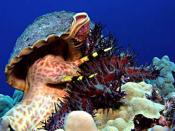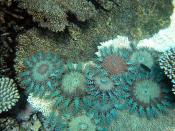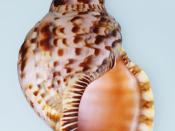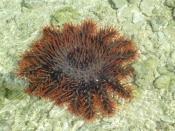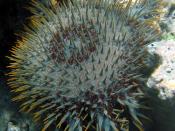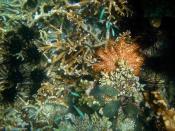Crown of Thorns Starfish
�
The Great Barrier Reef (GBR) is the largest collection of coral reefs in the world. It extends over 2000km off the northeastern coast of Australia and is home to a very diverse range of living creatures. Coral Reefs form in areas where temperatures don't fall below 18 degrees Celsius for long periods at a time, so are usually found 30 degrees north and south of the equator. Most require very saline water. Reefs are very shallow with clear water to allow light to penetrate.
Due to the GBR's symbiotic nature it is said by many to be a large living organism. Experts suggest that some parts of the reef could be up to 20 million years old, with most of the visible coral only developing over the past 2 million years. Generating over 1 billion dollars every year for the tourism industry the GBR is a major contributor to the Australian economy.
But there is a creature that threatens this natural resource.
The crown-of-thorns starfish (COTS) is one of the only animals that feeds on living coral tissue, it is named for the dense covering of long, extremely sharp spines on its surface that are known to have a toxic reaction in humans. Other characteristics include, a mouth surrounded by short blunt spines, a stomach and hundreds of tiny feet that can be seen from under each arm. The COT diet consists of soft corals and gorgonians (sea whips) to echinoids (sea urchins), clams and algae. They have also been observed to eat each other. A single COTS can consume up to 6 square meters of living reef per year.
During normal conditions, these starfish pose little threat to the reef on a large scale, but when an outbreak occurs the result is catastrophic. If it is not re-infested, a reef may recover a COT outbreak in 10 to 20 years but many reefs become re-infested before it has recovered. This has caused some scientists to speculate that continued re-infestation might result in reefs becoming devastated for long period of time.
The COTS has very high reproductive capacity with each female being able to lay millions of eggs in one breeding season. One of the main hypotheses as to the survival of larvae is the runoff of nutrients from fertilizers near costal areas, causing the water to become rich with nutrients. This results in a phytoplankton bloom that provides more food for crown-of-thorns larvae.
There are very few animals that are willing to attack the toxin-ridden starfish, but surprisingly, some creatures prey on them. Predators include the Giant Triton, a species of shrimp, a species of worm and various fish. The decline of these predators, due to over harvesting and pollution is also a major factor to the increase the population of the starfish, making outbreaks more likely to occur.
There are many ways to prevent COT from plaguing our reefs such as the breeding of such creatures as the Giant Triton. Divers also kill them by injecting the starfish's own stomach acid into each of their many legs although this is a long and tedious effort because if even one leg is missed the sea star can live on. Also the drastic change in farming and pollution i.e. less fertilizers can decrease the numbers of phytoplankton.
The crown-of-thorns starfish are a threat to the environment on the Great Barrier Reef, but the problem can be solved with time, lots of work and monitoring by biologists and researchers in the region.
It injects its saliva and paralyzes its prey.
�
Bibliography
Books
Shaw, Jeff, 2007, "Reef Invader: The Crown of Thorns Starfish"
Johnson, Craig, Crown-of-Thorns Starfish on the Great Barrier Reef
Vaisutis, Justine, 2005, Queensland and the Great Barrier Reef, Lonely Planet
McGovern, Ann, 1989, Down Under, Down Under
Internet
Aims Research, "Reef Monitoring", April 30, 2003, (online) http://www3.aims.gov.au/pages/research/reef-monitoring/ltm/ltm20030307-gbr.html
"The Crown of Thorns", (online) http://www.tellusconsultants.com/Thread/ACANTH.HTM
"Crown of Thorns Starfish", 2006, (online) http://www.answers.com/topic/crown-of-thorns-starfish
"The Great Barrier Reef Australia" (online) http://www.barrierreefaustralia.com/
�
Damion Jones
